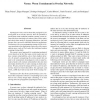Free Online Productivity Tools
i2Speak
i2Symbol
i2OCR
iTex2Img
iWeb2Print
iWeb2Shot
i2Type
iPdf2Split
iPdf2Merge
i2Bopomofo
i2Arabic
i2Style
i2Image
i2PDF
iLatex2Rtf
Sci2ools
DSN
2009
IEEE
2009
IEEE
Verme: Worm containment in overlay networks
Topological worms, such as those that propagate by following links in an overlay network, have the potential to spread faster than traditional random scanning worms because they have knowledge of a subset of the overlay nodes, and choose these nodes to propagate themselves; and also because they can avoid traditional detection mechanisms. Furthermore, this worm propagation strategy is likely to become prevalent as the deployment of networks with a sparse address space, such as IPv6, makes the traditional random scanning strategy futile. We present a novel approach for containing topological worms based on the fact that some overlay nodes may not have common vulnerabilities, due to their platform diversity. By properly reorganizing the overlay graph, this can lead to the containment of topological worms in small islands of nodes with common vulnerabilities that only have knowledge of themselves or nodes running on distinct platforms. We also present the design of Verme, a peer-to-peer ...
| Added | 20 May 2010 |
| Updated | 20 May 2010 |
| Type | Conference |
| Year | 2009 |
| Where | DSN |
| Authors | Filipe Freitas, Edgar Marques, Rodrigo Rodrigues, Carlos Ribeiro, Paulo Ferreira, Luís Rodrigues |
Comments (0)

